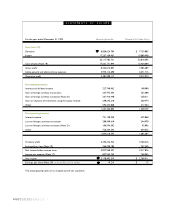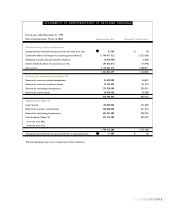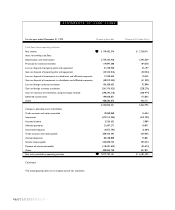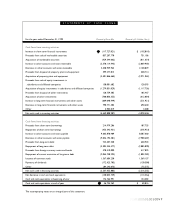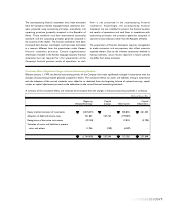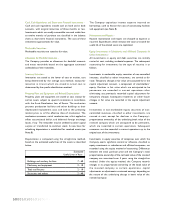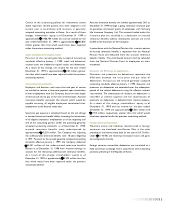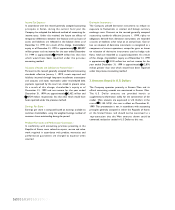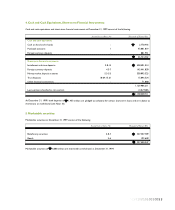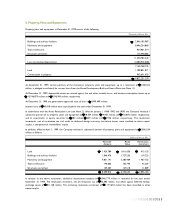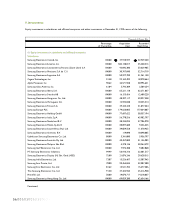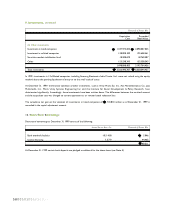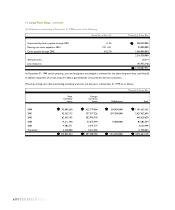Samsung 1999 Annual Report Download - page 51
Download and view the complete annual report
Please find page 51 of the 1999 Samsung annual report below. You can navigate through the pages in the report by either clicking on the pages listed below, or by using the keyword search tool below to find specific information within the annual report.
Certain of the accounting policies for investments stated
above represent revised policies that were adopted in the
current year in accordance with revisions in generally
accepted accounting principles in Korea. As a result of these
changes, shareholders’ equity as of December 31, 1999 is
approximately 1,908,784 million less and net income for the
year ended December 31, 1999 is approximately 305,855
million greater than that which would have been reported
under the previous accounting method.
Stock and Debenture Issuance Costs -
Pursuant to the revised generally accepted accounting
standards effective January 1, 1999, stock and debenture
issuance costs are credited to capital surplus and debentures.
As a result of this change, net income for the year ended
December 31, 1999 is approximately 230 million greater
than that which would have been reported under the previous
accounting method.
Accrued Severance Benefits -
Employees and directors with more than one year of service
are entitled to receive a lump-sum payment upon termination
of their employment with the Company, based on their length
of service and rate of pay at the time of termination. Accrued
severance benefits represent the amount which would be
payable assuming all eligible employees terminated their
employment at the balance sheet date.
Severance pay expense is calculated based on the net change
in accrued severance benefit liability assuming the termination
of all eligible employees’ employment as of the beginning and
end of the accounting period. Under the prevailing generally
accepted accounting standards, as of December 31, 1990,
accrued severance benefits were underaccrued by
approximately 42,255 million. The Company was adjusting
the underaccrued severance benefits over 10 years beginning
in 1991. Pursuant to the revised generally accepted accounting
standards effective January 1, 1999, the Company deducted
8,451 million of the underaccrued severance benefits
balance as of December 31, 1998 from retained earnings to
account for the remaining underaccrued severance benefits.
As a result of this change, shareholders’ equity as of
December 31, 1999 is approximately 4,225 million less than
that which would have been reported under the previous
accounting method.
Accrued severance benefits are funded approximately 56% at
December 31, 1999 through a group severance insurance plan
to guarantee retirement grants of employees with Samsung
Life Insurance Company, Ltd. The amounts funded under this
insurance plan are classified as a deduction to accrued
severance benefits liability. Subsequent accruals are to be
funded at the discretion of the Company.
In accordance with the National Pension Act, a certain portion
of accrued severance benefits is deposited with the National
Pension Fund and deducted from the accrued severance
benefits liability. The contributed amount shall be refunded
from the National Pension Fund to employees on their
retirement.
Discounts and Premiums on Debentures -
Discounts and premiums on debentures represent the
difference between the issue price and par value of
debentures. Pursuant to the revised generally accepted
accounting standards effective January 1, 1999, discounts and
premiums on debentures are amortized over the redemption
period of the related debentures using the effective interest
rate method. The amortization of discount on debentures is
recorded as interest expense and the amortization of
premiums on debentures is deducted from interest expense.
As a result of this change, shareholders’ equity as of
December 31, 1999 and net income for the year ended
December 31, 1999 are approximately 7,581 million and
1,912 million, respectively, greater than that which would
have been reported under the previous accounting method.
Foreign Currency Translation -
Monetary assets and liabilities denominated in foreign
currencies are translated into Korean Won at the rates
prevailing at the balance sheet date (in the case of U.S. Dollars,
US$1: 1,145.40) and resulting translation losses and gains
are recognized currently.
Foreign currency convertible debentures are translated at a
fixed conversion exchange rate in accordance with accounting
practices prevailing in the Republic of Korea.
10101001010010051





